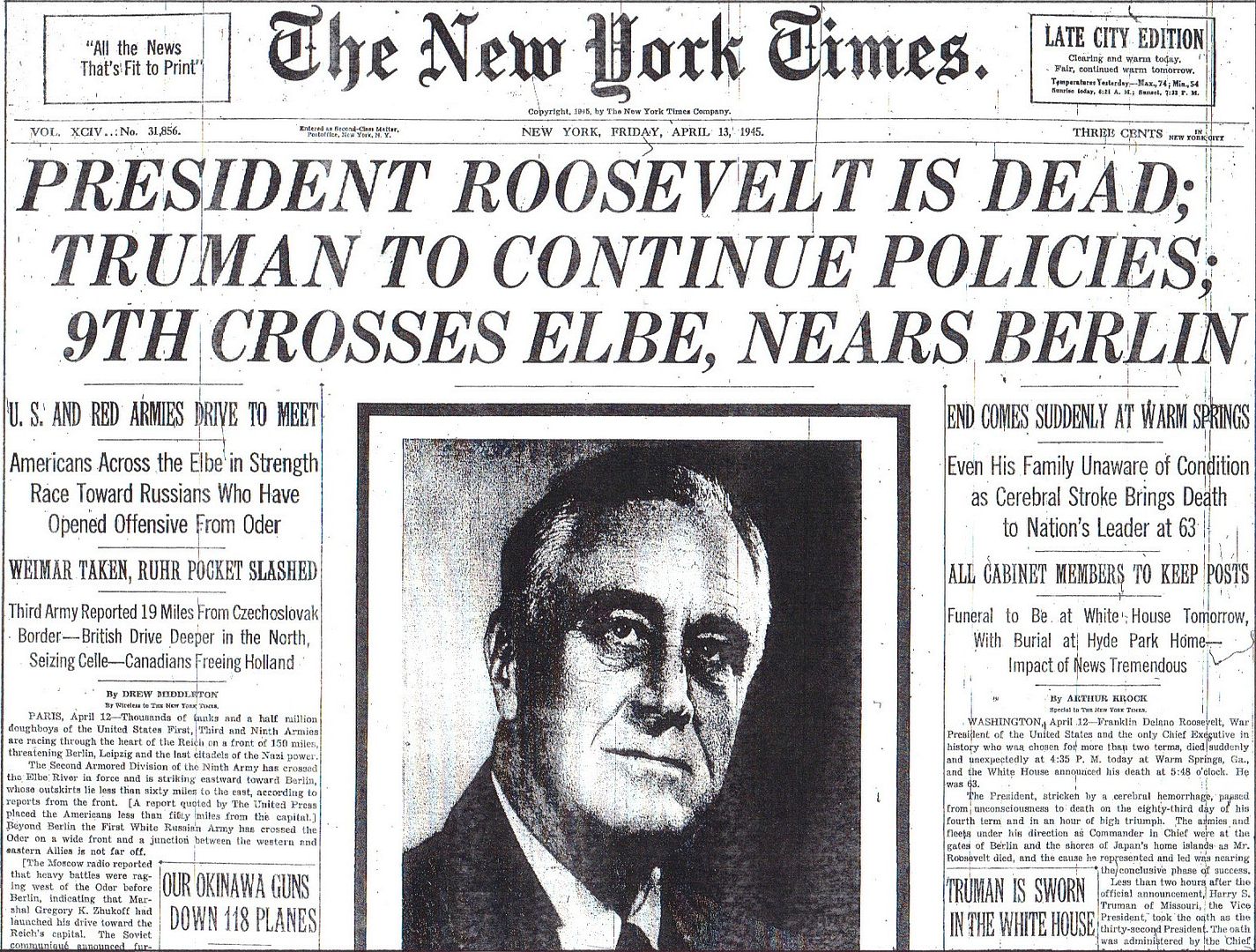
Posted on 04/13/2015 4:25:38 AM PDT by Homer_J_Simpson

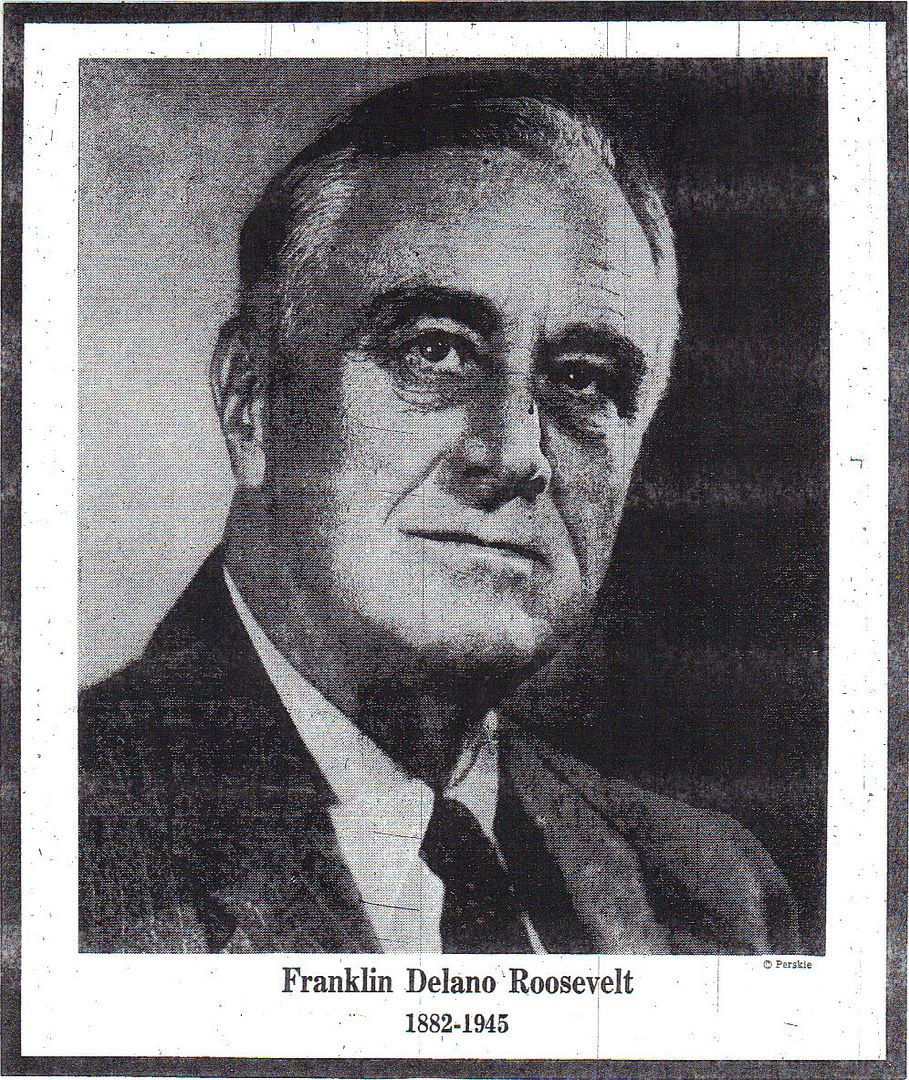
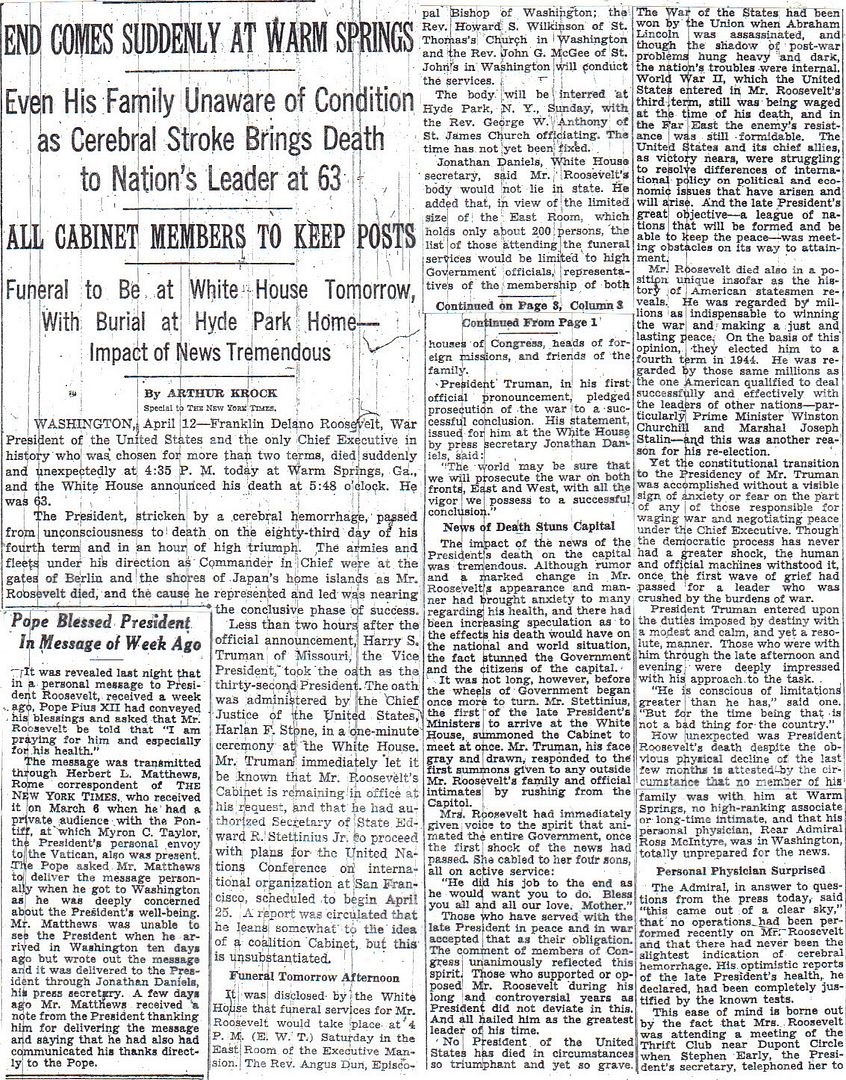


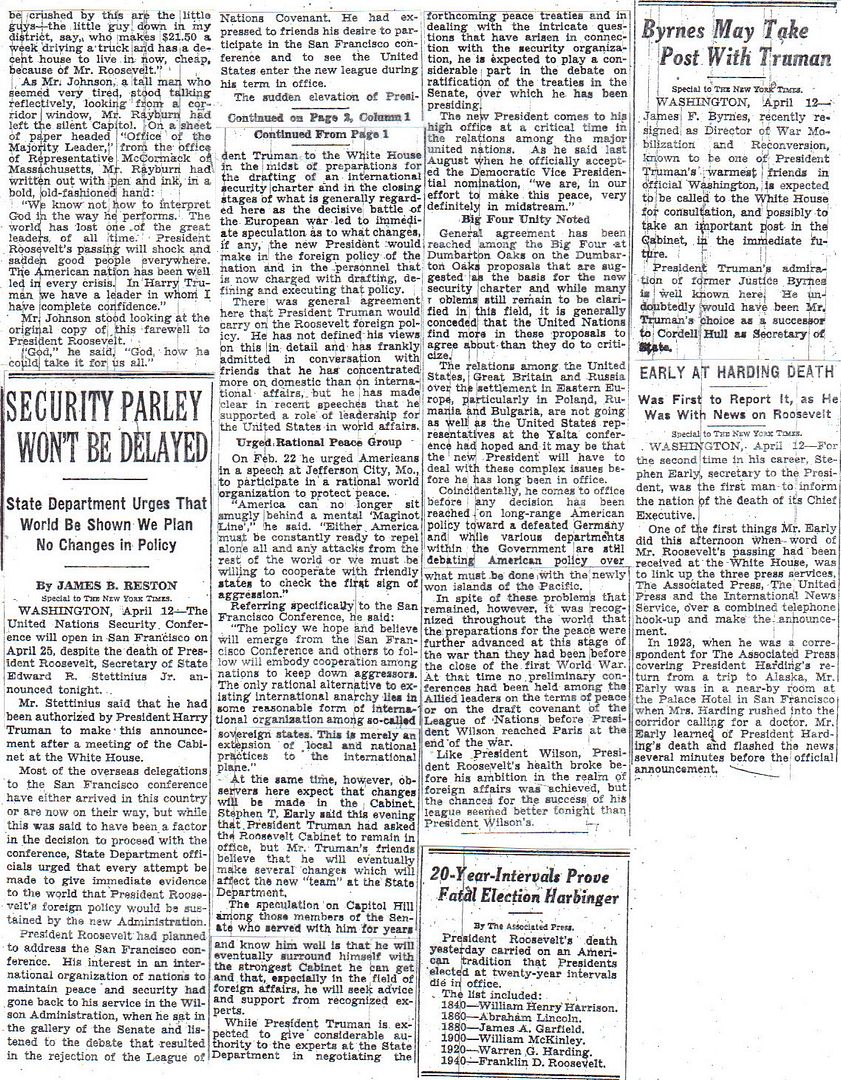
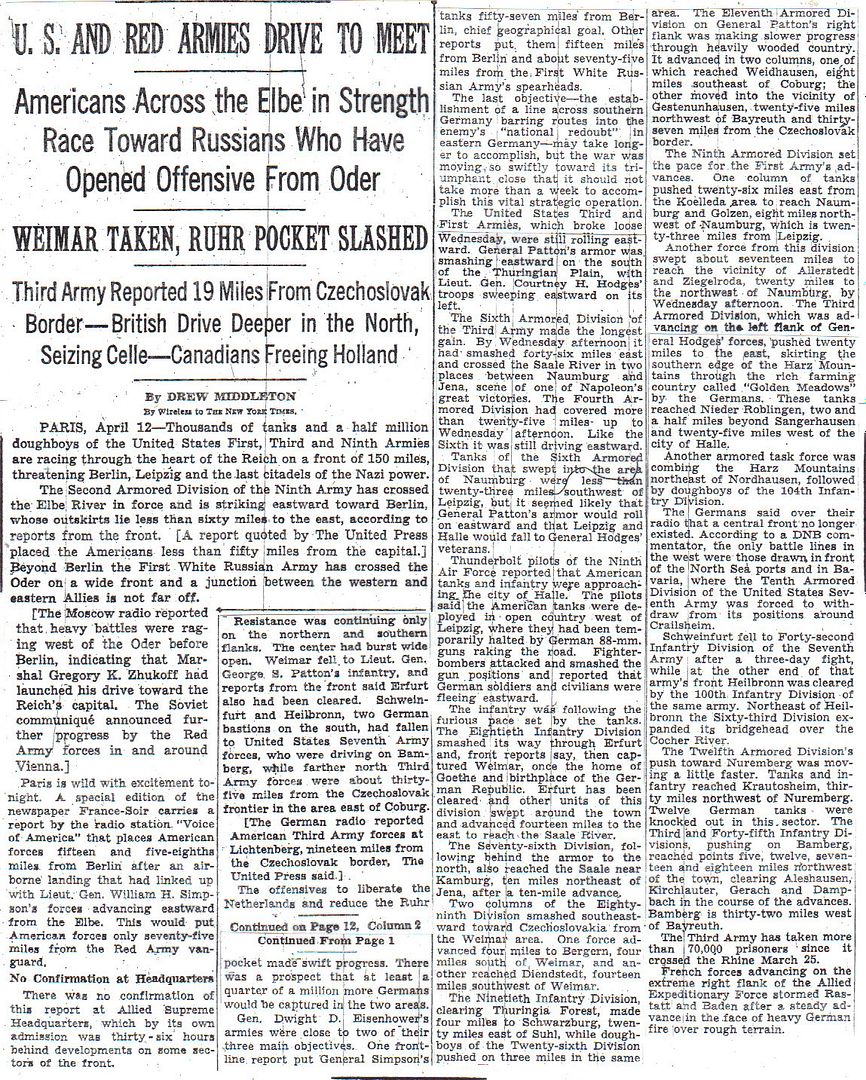
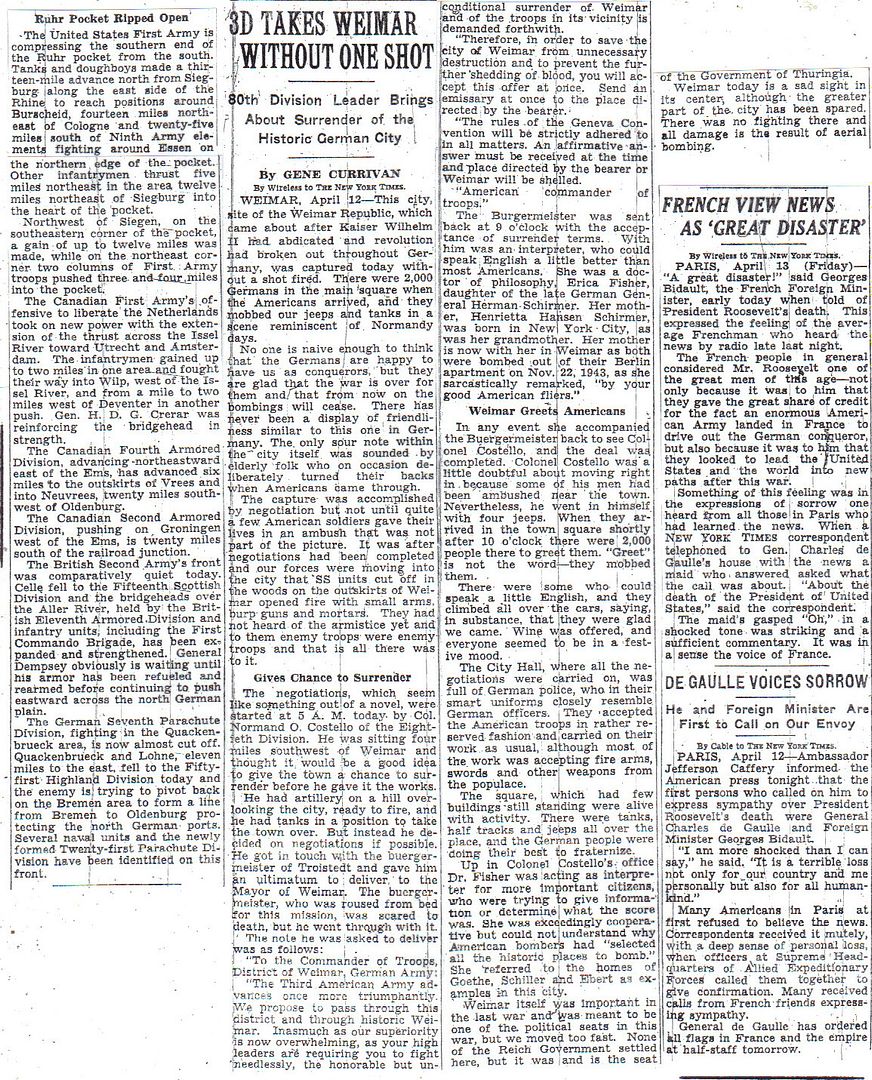
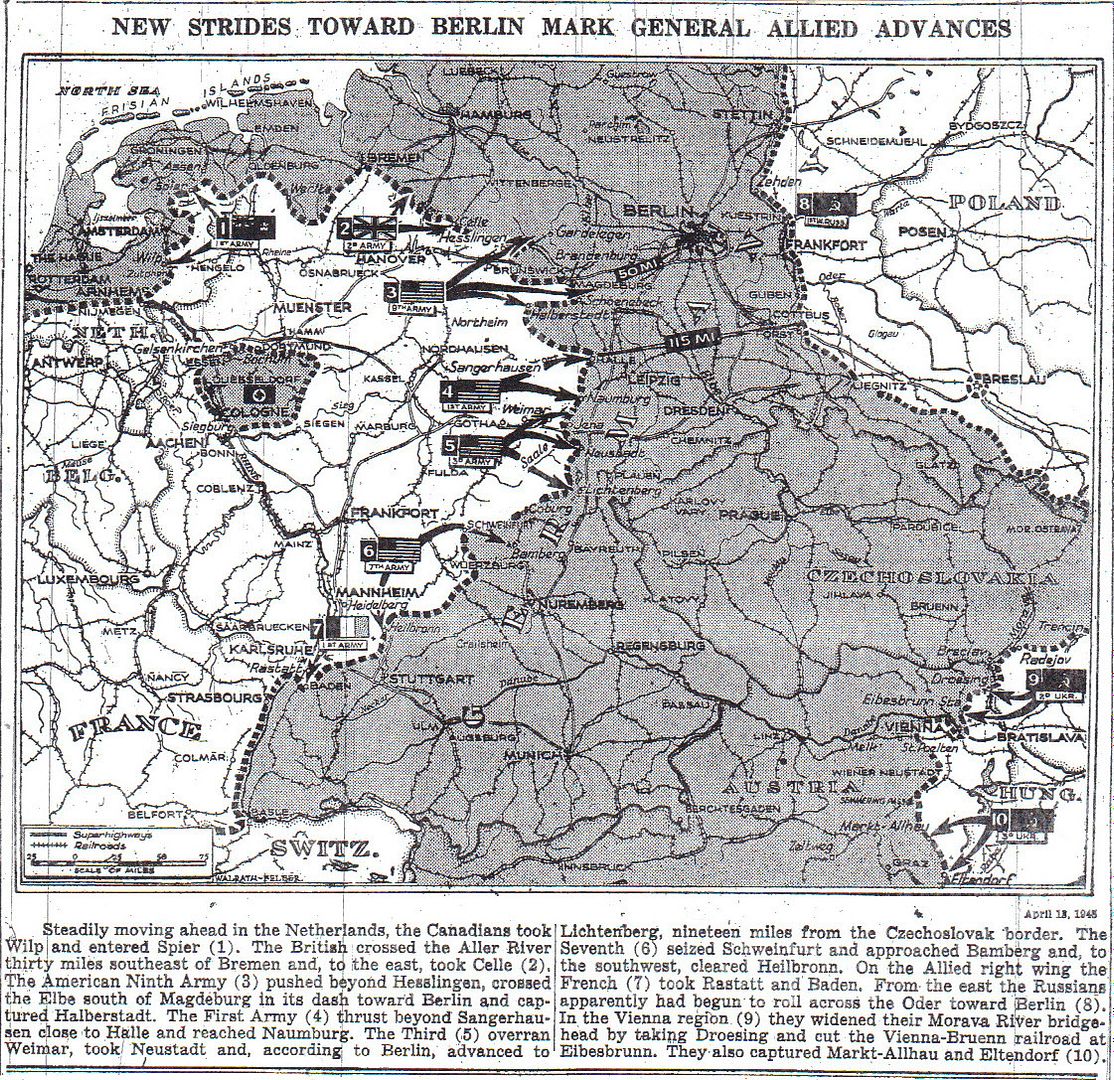
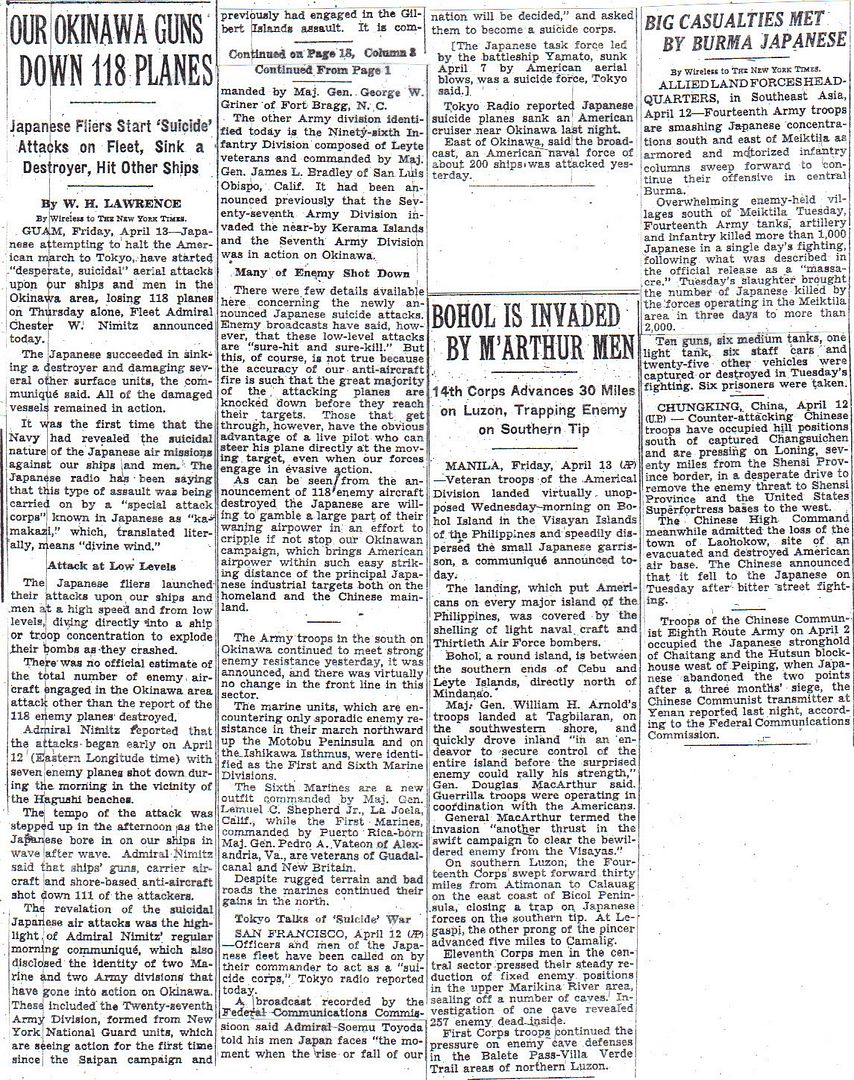
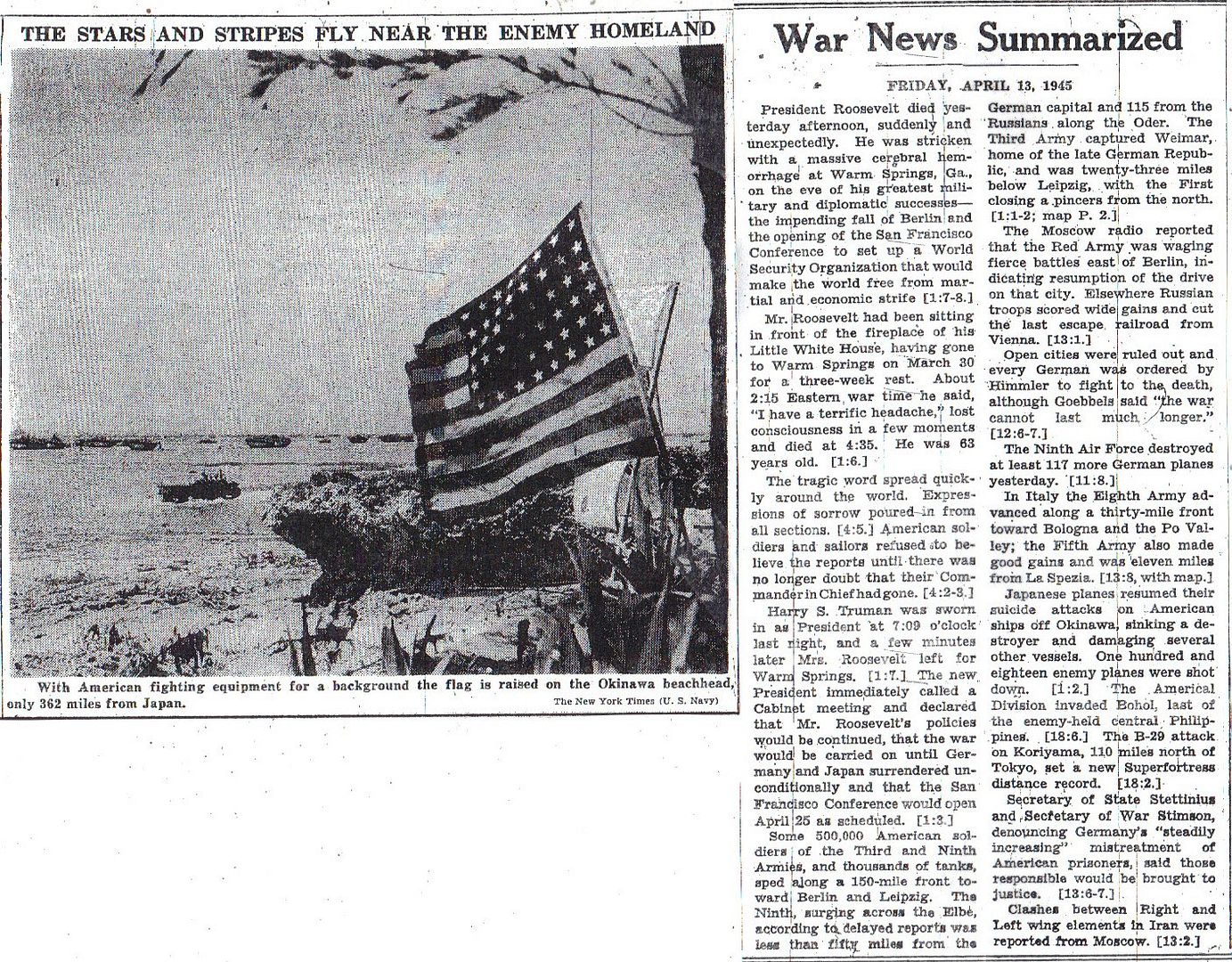
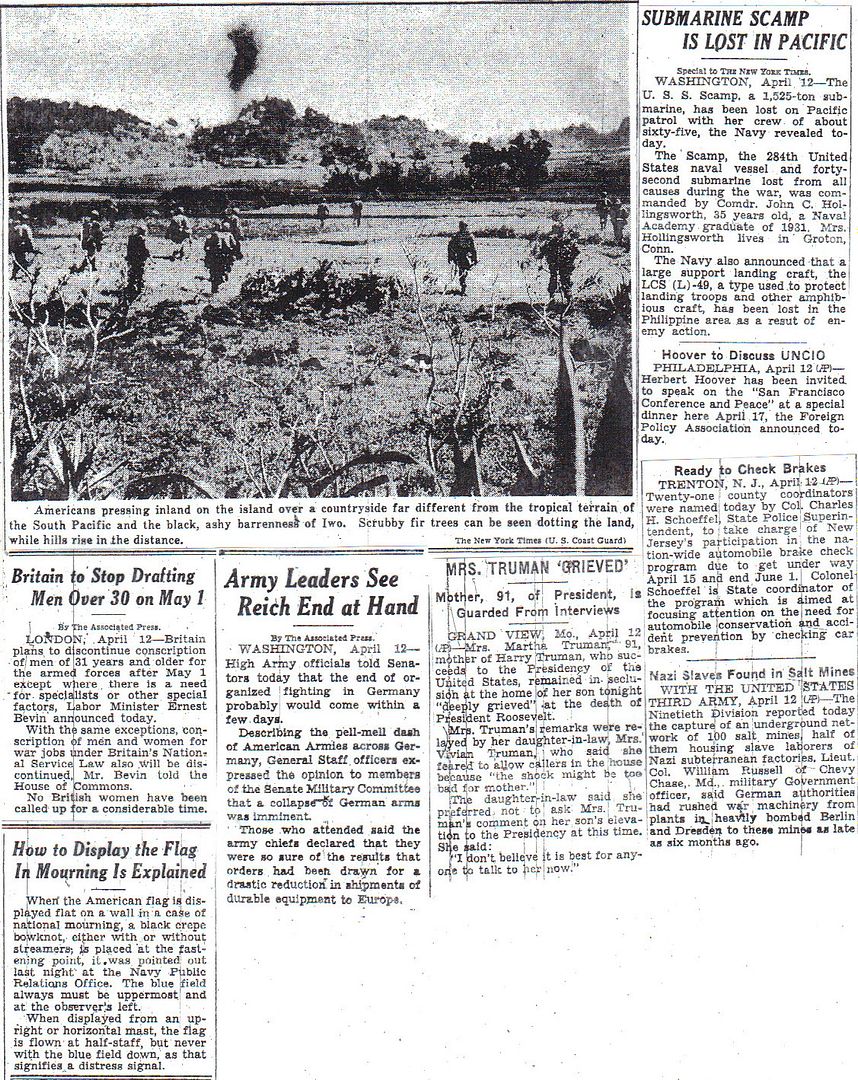
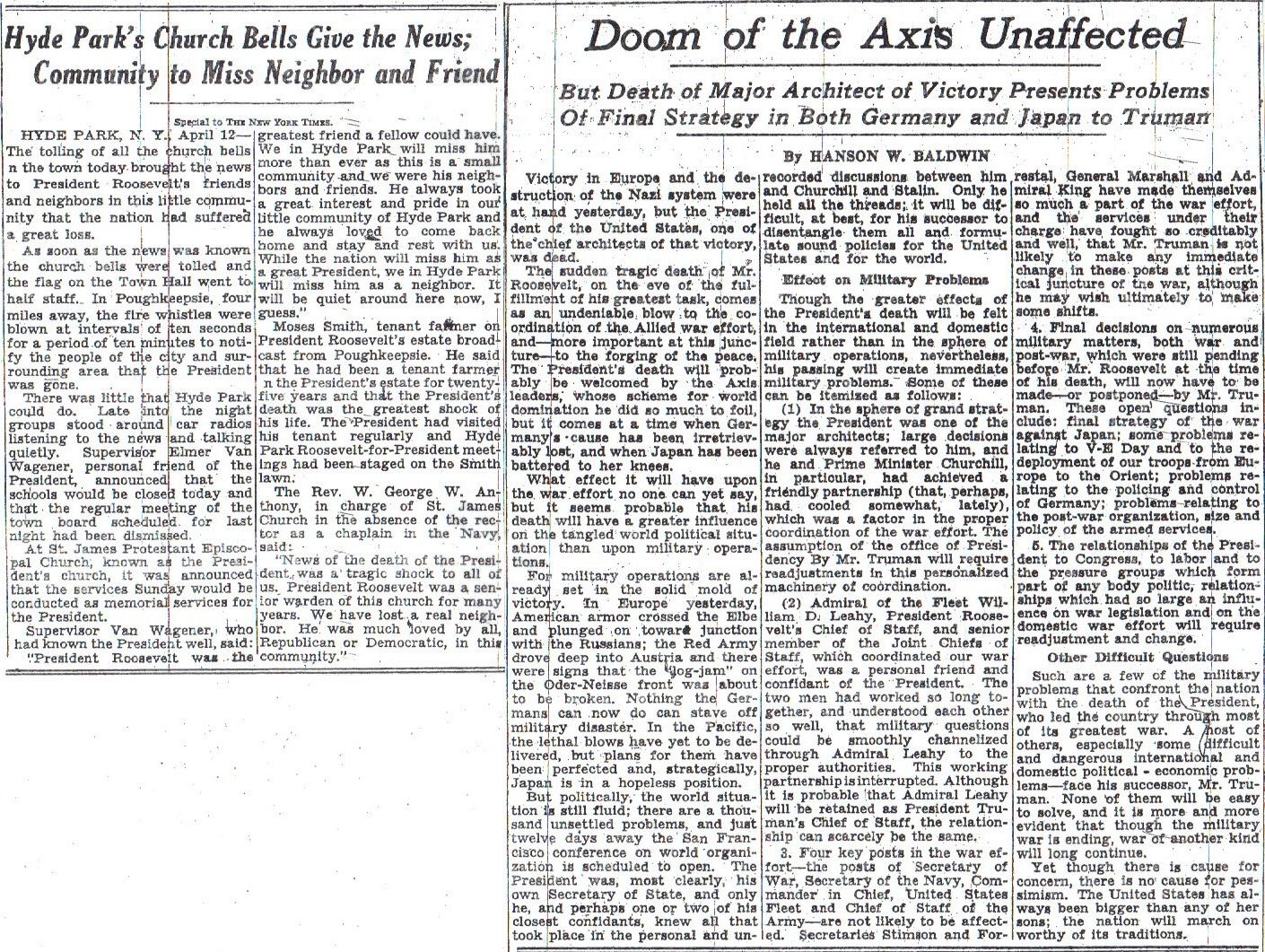
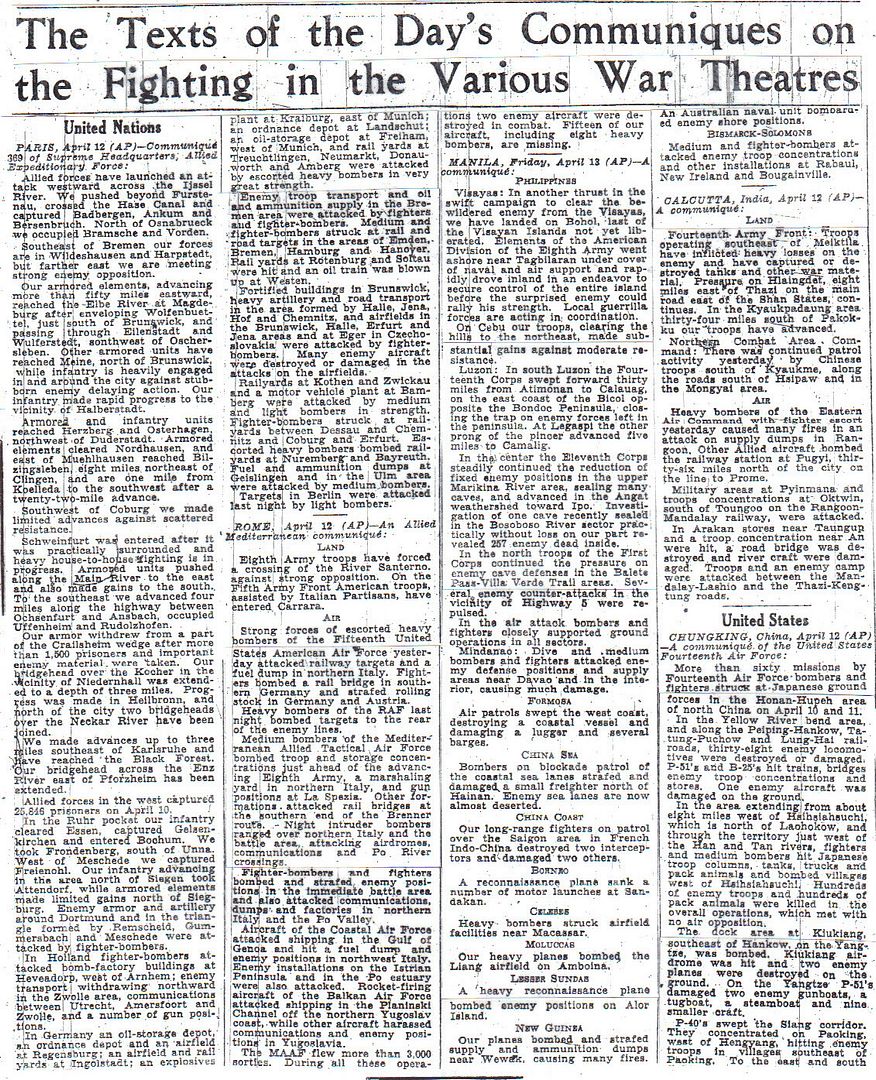
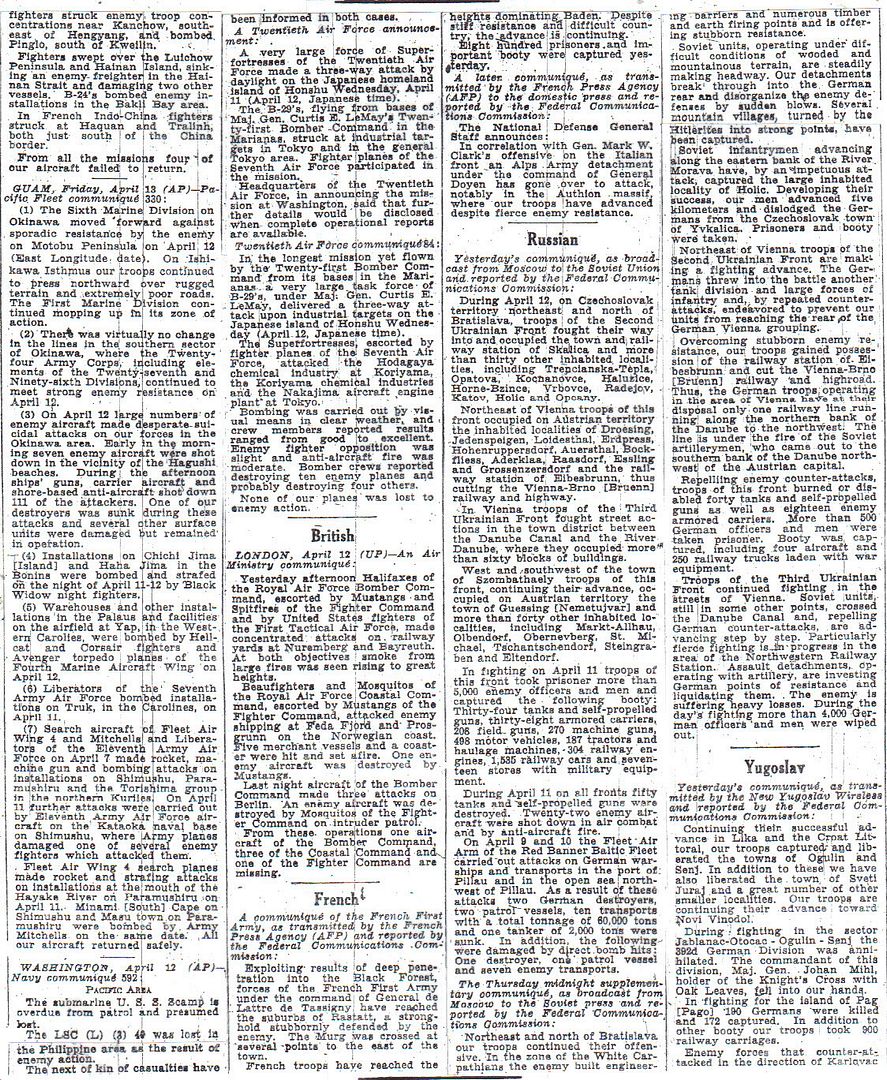
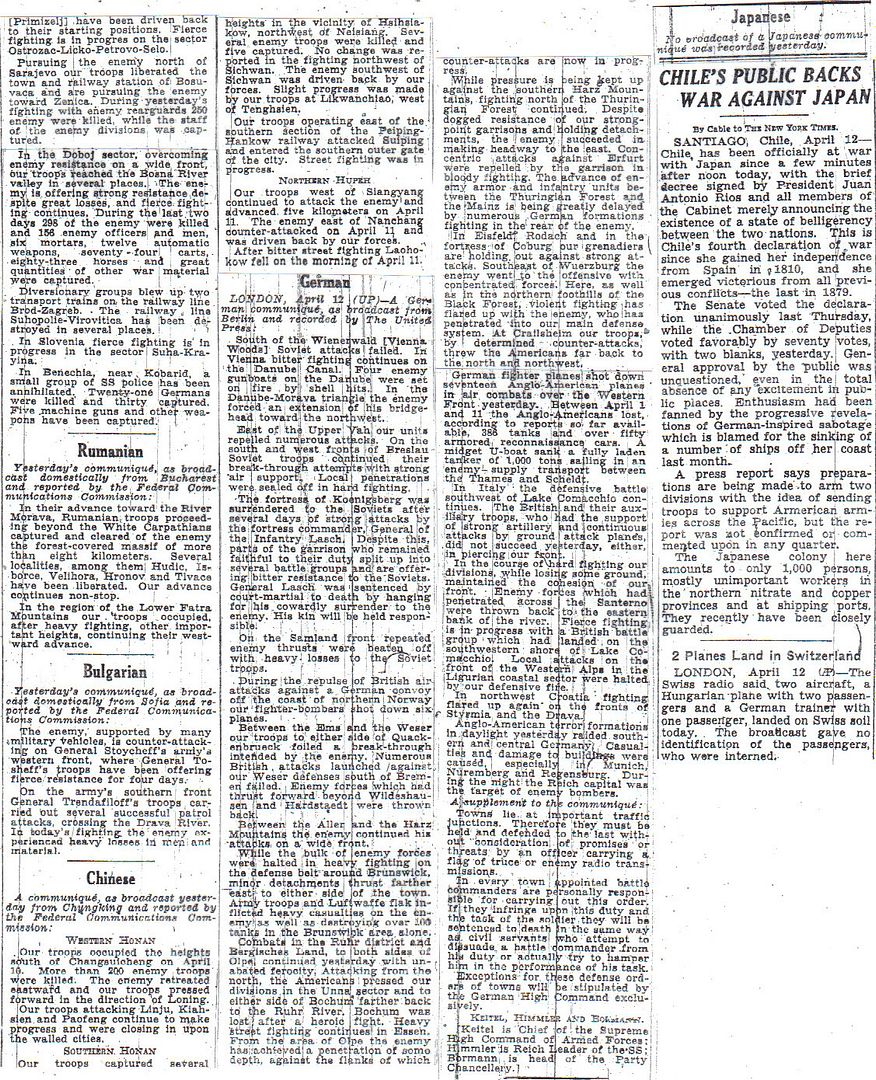

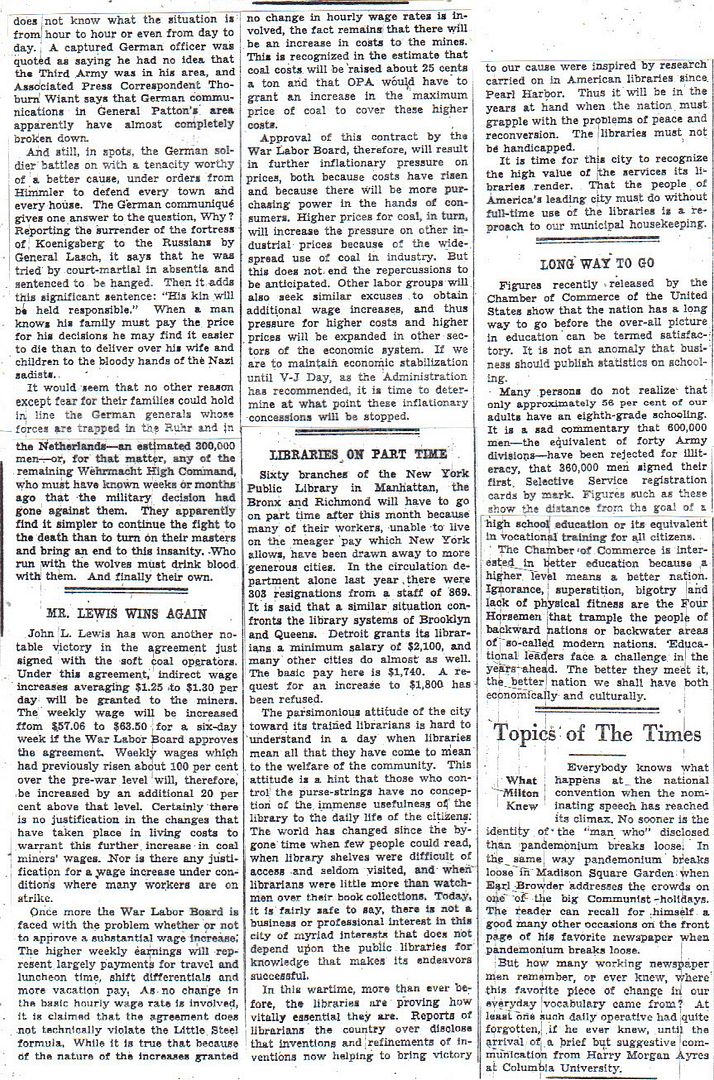
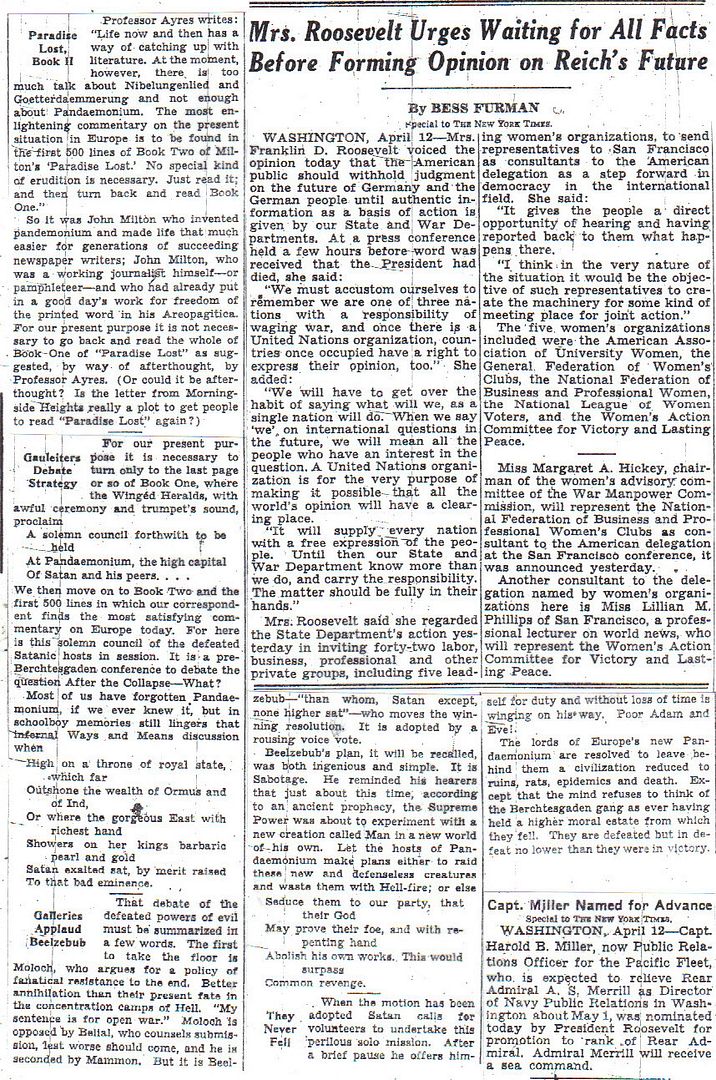
Editorials – 17-19
Franklin D. Roosevelt
Weimar and Nuremberg
Cutting Germany in Two
Mr. Lewis Wins Again
Libraries on Part Time
Long Way to Go
Topics of the Times
Mrs. Roosevelt Urges Waiting for All Facts Before Forming Opinion on Reich’s Future (by Bess Furman, first-time contributor) – 19
http://www.etherit.co.uk/month/3/13.htm
April 13th, 1945 (FRIDAY)
GERMANY: The liberation of German camps at Belsen and Buchenwald reveal the horrors of these camps to the world.
Eisenhower turns down his third chance to capture Berlin, saying that it is just a political prize.
The US 83rd Infantry Division with several associated units, arrive at the west bank of the Elbe. The US Army XIXth Corps commander, Major General Raymond S. McLain order it to cross the Elbe and into territory assigned to the Red Army, and to prepare to advance east/northeast (in the direction toward Berlin).
Berlin: Officially Germany reacted to the news of President Roosevelt’s death with a correct silence. The Nazi leaders, however, greeted it as a ray of light in what is now a desperate situation for them. “My Führer,” Josef Göbbels told Hitler, “I congratulate you. Roosevelt is dead. It is written in the stars that the second half of April will be the turning point for us.” The Nazis believe that Roosevelt’s death will be the signal for the western allies and the Soviet Union to fall out. Some plan to hold out in redoubts in north and south Germany until this occurs. Other Germans fear that Roosevelt’s death leaves them to the possibly less tender mercies of Churchill and Stalin.
Adolf Hitler proclaims from his underground bunker that deliverance was at hand from encroaching Russian troops—Berlin would remain German. A “mighty artillery is waiting to greet the enemy,” proclaims Der Fuhrer.
The Nazi have forced Allied PoWs to march up to 500 miles across Europe on starvation rations, according to reports published today in British newspapers The reports allege that of 6,000 Russians, Britons and Americans who set out in January, only 533 are still alive.
The Russians came from camps in Poland and the British and Americans from Stalag VIIIA, near Breslau. In January both groups marched to Gorlitz, in Silesia. In February they set out again. Most of them died from starvation, exhaustion or dysentery, and a few from the random cruelty of the guards.
The Eighth Air Force flies Mission 945: The AAF claims 284-0-220 Luftwaffe aircraft. 212 B-17s, escorted by 256 P-51s, attack the marshalling yard at Neumunster visually; 2 B-17s are lost. The escort claims 137-0-83 Luftwaffe aircraft in the air; 6 P-51s are lost. During this mission, 97 P-47s and P-51s fly a freelance mission in support of the bombers; they claim 147-0-137 aircraft on the ground; a P-47 and a P-51 are lost. During Mission 946 flown that night, 10 B-24s bomb the Beizenburg rail junction without loss.
Fighter-bombers of the Ninth Air Force’s IX Tactical Air Command fly a special mission against the HQ of Field Marshall Walter Model’s Army Group B at Haus Waldesruh in the Ruhr pocket; the air attack is followed by an artillery barrage; as a result the HQ is moved to Haan. IX Tactical Air Command pilots sight Soviet fighters in the air for the first time. Weather grounds the 9th Bombardment Division. Fighters fly patrols and armed reconnaissance, and support the US XVIII Corps in the Huckeswagen and Hagen areas, the III Corps between the Ruhr and Honne Rivers, the 3d Armored Division on the Saale River in the Alsleben, Nelben and Friedeburg area, the XX Corps astride and between the Weisse Eister and Zwickauer Mulde Rivers north of Gera, the XVI Corps northwest of Hagen, the 2d Armored Division in the Elbenau-Grunwalde area, and the 5th Armored Division along the Elbe River in the Tangermunde area.
1st Lt. Shannon E. Estill, USAAF”> USAAF, is flying a P-38-J Lightning, when it is struck by Anti-Aircraft fire while attacking targets in eastern Germany. Another U.S. pilot reports seeing Estill’s aircraft explode and crash. (William L. Howard) More...
AUSTRIA: Vienna falls to the Soviet Army. As agreed by the Allies in 1943, it appears that Austria will not be treated as a conquered nation. Moscow radio said tonight that because the people of Vienna and other parts of Austria had helped the Red Army fight the Germans they had “saved the honour of the Austrian nation.”
ITALY: Twelfth Air Force B-25s are restricted by weather to 1 mission, an attack on a road bridge at Mollinella; fighter bombers continue to hit communications and dumps in the Po Valley and guns in the La Spezia area; during the night of 12/13 April, A-20s and A-26 Invaders attack Po River crossings at San Benedetto Po, Ostiglia, Piacenza, and Casalmaggiore, bridges at San Ambrogio di Valpolicella, and motor transport and targets of opportunity in the Milan area.
BURMA: 30+ Tenth Air Force P-47s and P-38s attack troops and supplies in the Hamn gai, Loi-hseng, and Wan Yin areas and sweep roads south of the bomb line in central Burma; air transport operations to the front areas total 450 sorties.
CHINA AND FRENCH INDOCHINA: 6 Fourteenth Air Force B-25s hit a fort at Bac Ninh. 11 B-25s bomb the railroad yards and warehouse area at Kaifeng and 6 knock out a bridge at Ningming; 7 B-25s hit shipping in the South China Sea and Bakli Bay on Hainan Island and the town areas of Tenghsien and Liuchow; 4 others, along with 5 P-51s, knock out a bridge and hit the town area and shipping at Puchi; 24 P-38s and P-51s knock out 3 bridges, damage another, and hit several targets of opportunity in northern French Indochina; about 140 fighter-bombers fly armed reconnaissance and strikes throughout southern and eastern China, hitting rail, road, and river traffic, town areas, troops, and general targets of opportunity.
Far East Air Forces B-24s bomb the Hong Kong waterfront (Taikoo Docks) and storage areas in Canton.
FORMOSA: RN aircraft from the RN’s Task Force 57 again attack airfields. TF 57 then retires to refuel at sea and return to its station off the Sakishima Islands in the Ryukyu Islands.
Far East Air Forces B-24s bomb airfields at Tainan and Okayama while B-25s attack railroads.
JAPAN: XXI Bomber Command flies Mission 67 during the night of 13/14 April:
327 B-29 Superfortresses bomb the Tokyo arsenal area; 3 others hit targets of opportunity; 7 B-29s are lost.
MARIANA ISLANDS: 2 Seventh Air Force P-61 Black Widows based on Saipan bomb and strafe Pagan Island.
NORTH PACIFIC: 18 Guam-based Seventh Air Force B-24s bomb enemy positions on Marcus Island in the N Pacific.
OKINAWA: Off Okinawa, destroyer escort USS Connolly (DE-306) is damaged by kamikaze.
On the island, Technical Sergeant Beauford T. Anderson of the United States Army, 381st Infantry, 96th Infantry Division, single-handedly kills 25 Japanese during an attack on his companies’ position. (MOH)(Drew Philip Halévy)
PACIFIC OCEAN: Six Japanese ships are sunk at sea:
- Submarine USS Parche (SS-384) sinks an auxiliary minesweeper and a guardboat off northern Honshu, Japan.
- RN submarine HMS Stygian sinks an auxiliary minesweeper off Bali in the East Indies.
- An auxiliary submarine chaser is sunk by aircraft northwest of Hainan Island, China.
- Mines laid by USAAF B-29 Superfortresses in Japanese waters sinks two cargo ships and damage a coast defence vessel.
COMMONWEALTH OF THE PHILIPPINES: Ft. Drum, a “concrete battleship” in Manila Bay is attacked with 5,000 gallons of fuel oil and burned out over the next 5 days.
23 Seventh Air Force B-24s from Angaur Island, Palau Islands, bomb personnel and storage areas at Kabacan on Mindanao Island.
The Far East Air Forces flies numerous sweeps are flown over the Cagayan Valley on Luzon and ground support missions are continued on Luzon, Cebu, and Negros Islands. On Mindanao Island, B-24s bomb the Davao area and B-25s hit various targets on Mindanao and in the Sulu Archipelago.
TERRITORY OF ALASKA: ALEUTIAN ISLANDS: On Attu Island, 27 Eleventh Air Force P-38s and P-40s scramble following radar reports of unidentified plots; later, they shoot down 9 of 11 Japanese paper bomb-balloons sighted over the western Aleutians.
CANADA: Beginning of intimidation campaign towards Japanese Canadians living in British Columbia to move to Eastern Canada or be deported to Japan.
CHILE: Santiago: CHILE declares war on Japan.
17 days and Hitler also dies......or does he?
Re: “20 year intervals” - pure coincidence.
I’m sure the guys who will be elected in 1960 and 1980 won’t have to worry about being shot or anything like that.
Interesting that LBJ was one of the young guys in Congress interviewed by this paper for his reaction.
Draft of statement from James Byrnes to Soviet Ambassador, April 13, 1945, War Crimes File, Rosenman Papers, Harry S. Truman Presidential Museum & Library





Letter from American soldier describes Gardelegen massacre on April 13, 1945

This photo of the burned bodies in the Gardelegen barn was on the cover of Life magazine on May 7, 1945
(Scroll down for the photos which illustrate John Lobb’s experience at Gardelegen)
Here is the letter which I have reproduced verbatim, misspellings and all:
Camp Washington, France Friday, 13, 1945
Dear Mom & Dad
Well nobody can say that I have’nt been trying to keep up on the mail situation lately. I think this is the fourth letter that I have written in the past seven days. I am going to send a few pictures that we took when we were in Gardalagen, some time ago.
They are all facts that cant be denied by some Jerry politician.
The pictures have numbers on them, so you will understand some of the things and people around them. No: 1, is the pictt re of the barn that all of the people that were found inside still smouldering, when it was discovered. Picture No:2 is the same barn with all the bodies outside by this time, just look at the amount that were burnt at one time, in this place outside there was a machine gun set up for anyone that tried to escape. Picture No:3 is a closeup so you can see just how the people were burnt, not enough to make it a quick death, only enough so that they would suffer then smother from the smoke.
Picture No:4 shows the trench outside where many more bodies were found proving that this was’nt the first time that such things went on in that barn. The civilians in this picture are digging up all of the bodies that were buried for weeks in a big ditch, they were made to dig them up, I never seen so many people at one time so damn sick. Picture No:5 just about tells its own story, that is the final count of all the people that could be found. Now all of the bodies have a seperate grave, and each family in the town of Gardilagen, is assigned to take care of a grave for as long as that family or any of thair childrens family live on this earth. I have never seen an American soldier so mad in all my time as the ones there were.
You can give these pictures to the Times Herald if they can use them just to say show some people what a nice innocent race the Jerr’s are.
Well Folks guess that I’ll close now heres hoping that I see you all soon.
All my love
Jack

The barn where the Gardelegen massacre took place on April 13, 1945
The photo above shows soldiers of F Company, 2nd Battalion, 405th Regiment, U.S. 102nd Infantry Division on April 15, 1945 as they inspect the barn on the Isenschnibbe estate, a few miles outside the town of Gardelegen, where the mass murder took place on April 13, 1945.
The 102nd Division soldiers had arrived in Gardelegen on the evening of April 14th and had accepted the surrender of the Luftwaffe air base. The German troops were most anxious to surrender to the Americans, rather than to the Russians who were only a few miles away on the other side of the Elbe river.

American soldiers took photos at the Gardelegen barn

Body of prisoner found inside the barn at Gardelegen

Prisoner who tried to escape by tunneling under the sliding door of the Gardelegen barn
The Gardelegen massacre was the cold-blooded murder of inmates that had been evacuated from the Dora-Mittelbau concentration camp and some of its sub-camps on April 3rd, 4th and 5th. Around 4,000 prisoners had been bound for the Bergen-Belsen, Sachsenhausen or Neuengamme concentration camps, but when the railroad tracks were bombed by American planes, they had been re-routed to Gardelegen, which was the site of a Cavalry Training School and a Parachutist Training School. The trains were forced to stop before reaching the town of Gardelegen and some of the escaped prisoners had terrorized the nearby villages, raping, looting and killing civilians.

Photo of all the bodies taken out of the barn

German civilians from the town of Gardelegen were forced to view the bodies

German civilians preparing the victims for burial
On Friday, April 13th, approximately 1050 to 1100 of the concentration camp prisoners were herded inside a grain barn, piled knee-high with straw, which had been previously doused with gasoline. The barn was then deliberately set on fire by German SS and Luftwaffe soldiers and boys from the Hitler Jugend, according to the survivors. Prisoners who tried to escape from the fire were machine-gunned to death by the Germans guarding the barn, including teen-aged boys in the Hitler Jugend. A total of 1016 prisoners were burned to death or shot as they tried to escape from the unlocked barn. Around 100 of the prisoners survived, including several Russian Prisoners of War who greeted the American soldiers and led them to the scene of one of the most ignominious war crimes of World War II.

German civilians digging graves for the victims

German civilians were forced to exhume bodies from a mass grave

Gardelegen victims were buried in a military style cemetery
The Gardelegen massacre was ordered by Gerhard Thiele, the Nazi party district leader in the town of Gardelegen.
http://www.presidency.ucsb.edu/ws/?pid=16602
Undelivered Address Prepared for Jefferson Day.
April 13, 1945
Franklin Roosevelt
“Americans are gathered together this evening in communities all over the country to pay tribute to the living memory of Thomas Jefferson-one of the greatest of all democrats; and I want to make it clear that I am spelling that word “democrats” with a small d.
I wish I had the power, just for this evening, to be present at all of these gatherings.
In this historic year, more than ever before, we do well to consider the character of Thomas Jefferson as an American citizen of the world.
As Minister to France, then as our first Secretary of State and as our third President, Jefferson was instrumental in the establishment of the United States as a vital factor in international affairs.
It was he who first sent our Navy into far-distant waters to defend our rights. And the promulgation of the Monroe Doctrine was the logical development of Jefferson’s far-seeing foreign policy.
Today this Nation which Jefferson helped so greatly to build is playing a tremendous part in the battle for the rights of man all over the world.
Today we are part of the vast Allied force—a force composed of flesh and blood and steel and spirit—which is today destroying the makers of war, the breeders of hatred, in Europe and in Asia.
In Jefferson’s time our Navy consisted of only a handful of frigates headed by the gallant U.S.S. Constitution—Old Ironsides—but that tiny Navy taught Nations across the Atlantic that piracy in the Mediterranean—acts of aggression against peaceful commerce and the enslavement of their crews—was one of those things which, among neighbors, simply was not done.
Today we have learned in the agony of war that great power involves great responsibility. Today we can no more escape the consequences of German and Japanese aggression than could we avoid the consequences of attacks by the Barbary Corsairs a century and a half before.
We, as Americans, do not choose to deny our responsibility.
Nor do we intend to abandon our determination that, within the lives of our children and our children’s children, there will not be a third world war.
We seek peace—enduring peace. More than an end to war, we want an end to the beginnings of all wars—yes, an end to this brutal, inhuman, and thoroughly impractical method of settling the differences between governments.
The once powerful, malignant Nazi state is crumbling. The Japanese war lords are receiving, in their own homeland, the retribution for which they asked when they attacked Pearl Harbor.
But the mere conquest of our enemies is not enough.
We must go on to do all in our power to conquer the doubts and the fears, the ignorance and the greed, which made this horror possible.
Thomas Jefferson, himself a distinguished scientist, once spoke of “the brotherly spirit of Science, which unites into one family all its votaries of whatever grade, and however widely dispersed throughout the different quarters of the globe.”
Today, science has brought all the different quarters of the globe so close together that it is impossible to isolate them one from another.
Today we are faced with the preeminent fact that, if civilization is to survive, we must cultivate the science of human relationships—the ability of all peoples, of all kinds, to live together and work together, in the same world, at peace.
Let me assure you that my hand is the steadier for the work that is to be done, that I move more firmly into the task, knowing that you—millions and millions of you—are joined with me in the resolve to make this work endure.
The work, my friends, is peace. More than an end of this war —an end to the beginnings of all wars. Yes, an end, forever, to this impractical, unrealistic settlement of the differences between governments by the mass killing of peoples.
Today, as we move against the terrible scourge of war—as we go forward toward the greatest contribution that any generation of human beings can make in this world- the contribution of lasting peace, I ask you to keep up your faith. I measure the sound, solid achievement that can be made at this time by the straight edge of your own confidence and your resolve. And to you, and to all Americans who dedicate themselves with us to the making of an abiding peace, I say:
The only limit to our realization of tomorrow will be our doubts of today. Let us move forward with strong and active faith.”

President Roosevelt has died? I didn’t even know he was sick!
George C. Gross
A Train Near Magdeburg

Foreword:
Excerpt from Wayne Robinson, Move out Verify: the Combat Story of the 743rd Tank Battalion (Germany, no publisher, 1945), 162-63:
There was another sidelight to the death of fascism in Europe. Only a few of the battalion saw it. Those who did will never forget it.
A few miles northwest of Magdeburg there was a railroad siding in wooded ravine not far from the Elbe River. Major Clarence Benjamin in a jeep was leading a small task force of two light tanks from Dog Company on a routine job of patrolling. The unit came upon some 200 shabby looking civilians by the side of the road. There was something immediately apparent about each one of these people, men and women, which arrested the attention. Each one of them was skeleton thin with starvation, a sickness in their faces and the way in which they stood-and there was something else. At the sight of Americans they began laughing in joy-if it could be called laughing. It was an outpouring of pure, near-hysterical relief.
The tankers soon found out why. The reason was found at the railroad siding.
There they came upon a long string of grimy, ancient boxcars standing silent on the tracks. In the banks by the tracks, as if to get some pitiful comfort from the thin April sun, a multitude of people of all shades of misery spread themselves in a sorry, despairing tableaux [sic]. As the American uniforms were sighted, a great stir went through this strange camp. Many rushed toward the Major's jeep and the two light tanks.
Bit by bit, as the Major found some who spoke English, the story came out.
This had been-and was-a horror train. In these freight cars had been shipped 2500 people, jam-packed in like sardines, and they were people that had two things in common, one with the other: They were prisoners of the German State and they were Jews.
These 2500 wretched people, starved, beaten, ill, some dying, were political prisoners who had until a few days before been held at concentration camp near Hanover. When the Allied armies smashed through beyond the Rhine and began slicing into central Germany, the tragic2500 had been loaded into old railroad cars-as many as 68 in one filthy boxcar-and brought in a torturous journey to this railroad siding by the Elbe. They were to be taken still deeper into Germany beyond the Elbe when German trainmen got into an argument about the route and the cars had been shunted onto the siding. Here the tide of the Ninth Army's rush had found them.
They found it hard to believe they were in friendly hands once more: they were fearful that the Germans would return. They had been guarded by a large force of SS troopers, most of whom had disappeared in the night. Major Benjamin, knowing there were many German Army stragglers still in the area, left one of the light tanks there with its accompanying doughboys as a protective guard. The Major then returned to Division headquarters to report the plight of these people.
For 24 hours, the crew of the tank remained on watch as their charges streamed about the vehicle, crying and laughing their thanks of rescue, and those who could told stories of slavery, oppression, torture, imprisonment, and death. To hear their stories, to see before them the results of inhuman treatment lifted still another corner of the cover which, on being removed, exposed the full cruel spirit of Nazism which permitted such things to be. And this was but one of the many such stories being brought to light as Allied soldiers ripped into the secrets of Adolph Hitler's Third Reich.
The train needed some badly needed food that night. More, the promise of plentiful food the next day was given to them. The commanding officer of the 823rd Tank Destroyer Battalion was seeing to it that such food would be available. He had ordered German farmers of the surrounding towns to stay up all night, if necessary, to get food to these people. Other Americans concerned themselves with locating living quarters to get the concentration camp victims away from the evil-smelling freight cars before more of them died and were covered by a blanket or just left lying in their last sleep beside the railroad tracks.
Sgt. George Gross (relayed to Matthew Rozell, March, 2002):
On Friday, April 13, 1945, I was commanding a light tank in a column of the 743rd Tank Battalion and the 30th Infantry Division, moving south near the Elbe River toward Magdeburg, Germany. After three weeks of non-stop advancing with the 30th from the Rhine to the Elbe as we alternated spearhead and mop-up duties with the 2nd Armored Division, we were worn out and in a somber mood because, although we knew the fighting was at last almost over, a pall had been cast upon our victories by the news of the death of President Franklin D. Roosevelt. I had no inkling of the further grim news that morning would bring. Suddenly, I was pulled out of the column, along with my buddy Sergeant Carrol Walsh in his light tank, to accompany Major Clarence L. Benjamin of the 743rd in a scouting foray to the east of our route. Major Benjamin had come upon some emaciated Finnish soldiers who had escaped from a train full of starving prisoners a short distance away. The major led our two tanks, each carrying several infantrymen from the 30th Infantry Division on its deck, down a narrow road until we came to a valley with a small train station at its head and a motley assemblage of passenger compartment cars and boxcars pulled onto a siding. There was a mass of people sitting or lying listlessly about, unaware as yet of our presence. There must have been guards, but they evidently ran away before or as we arrived, for I remember no firefight. Our taking of the train, therefore, was no great heroic action but a small police operation. The heroism that day was all with the prisoners on the train.

Major Benjamin took a powerful picture just as a few of the people became aware that they had been rescued. It shows people in the background still lying about, trying to soak up a bit of energy from the sun, while in the foreground a woman has her arms flung wide and a great look of surprise and joy on her face as she rushes toward us. In a moment, that woman found a pack left by a fleeing German soldier, rummaged through it, and held up triumphantly a tin of rations. She was immediately attacked by a swarm of skeletal figures, each intent upon capturing that prize. My yelling did no good, so that I finally had to leap from my tank and wade through weak and emaciated bodies to pull the attackers off the woman, who ran quickly away with her prize. I felt like a bully, pushing around such weak and starving fellow humans, but it was necessary to save the woman from great harm. The incident drove home to me the terrible plight of the newly freed inhabitants of the train.
I pulled my tank up beside the small station house at the head of the train and kept it there as a sign that the train was under American protection now. Carroll Walsh’s tank was soon sent back to the battalion, and I do not remember how long the infantrymen stayed with us, though it was a comfort to have them for a while. My recollection is that my tank was alone for the afternoon and night of the 13th. A number of things happened fairly quickly. We were told that the commander of the 823rd Tank Destroyer battalion had ordered all the burgermeisters of nearby towns to prepare food and get it to the train promptly, and were assured that Military Government would take care of the refugees the following day. So we were left to hunker down and protect the starving people, commiserating with if not relieving their dire condition.
I believe that the ranking officer of the Finnish prisoners introduced himself to me and offered to set up a perimeter guard. I think I approved and asked him to organize a guard, set out pickets, and handle the maintenance and relief of the outposts. However it happened, the guard was set up swiftly and efficiently. It was moving and inspiring to see how smartly those emaciated soldiers returned to their military duties, almost joyful at the thought of taking orders and protecting others again. They were armed only with sticks and a few weapons discarded by the fleeing German guards, but they made a formidable force, and they obviously knew their duties, so that I could relax and talk to the people. A young woman named Gina Rappaport came up and offered to be my interpreter. She spoke English very well and was evidently conversant with several other languages besides her native Polish. We stood in front of the tank as along line of men, women, and little children formed itself spontaneously, with great dignity and no confusion, to greet us. It is a time I cannot forget, for it was terribly moving to see the courtesy with which they treated each other, and the importance they seemed to place on reasserting their individuality in some seemingly official way. Each would stand at a position of rigid attention, held with some difficulty, and introduce himself or herself by what grew to be a sort of formula: the full name, followed by "a Polish Jew from Hungary"-or a similar phrase which gave both the origin and the home from which the person had been seized. Then each would shake hands in a solemn and dignified assertion of individual worth. Battle-hardened veterans learn to contain their emotions, but it was difficult then, and I cry now to think about it. What stamina and regenerative spirit those brave people showed!

Also tremendously moving were their smiles. I have one picture of several girls, specter-thin, hollow-cheeked, with enormous eyes that had seen much evil and terror, and yet with smiles to break one's heart. Little children came around with shy smiles, and mothers with proud smiles happily pushed them forward to get their pictures taken. I walked up and down the train seeing some lying in pain or lack of energy, and some sitting and making hopeful plans for a future that suddenly seemed possible again. Others followed everywhere I went, not intruding but just wanting to be close to a representative of the forces that had freed them. How sad it was that we had no food to give immediately, and no medical help, for during my short stay with the train sixteen or more bodies were carried up the hillside to await burial, brave hearts having lost the fight against starvation before we could help them.

The boxcars were generally in very bad condition from having been the living quarters of far too many people, and the passenger compartments showed the same signs of overcrowding and unsanitary conditions. But the people were not dirty. Their clothes were old and often ragged, but they were generally clean, and the people themselves had obviously taken great pains to look their best as they presented themselves to us. I was told that many had taken advantage of the cold stream that flowed through the lower part of the valley to wash themselves and their clothing. Once again I was impressed by the indomitable spirits of these courageous people.

I spent part of the afternoon listening to the story of Gina Rappaport, who had served so well as interpreter. She was in the Warsaw ghetto for several years as the Nazis gradually emptied the ghetto to fill the death camps, until her turn finally came. She was taken to Bergen-Belsen, where the horrible conditions she described matched those official accounts I later heard. She and some 2500 others, Jews from all over Europe, Finnish prisoners of war, and others who had earned the enmity of Nazidom, were forced onto the train and taken on a back-and-forth journey across Germany, as their torturers tried to get them to a camp where they could be eliminated before Russians on one side or Americans on the other caught up with them. Since the prisoners had little food, many died on the purposeless journey, and they had felt no cause for hope when they were shunted into this little unimportant valley siding. Gina told her story well, but I have never been able to write it. I received a letter from her months later, when I was home in San Diego. I answered it but did not hear from her again. Her brief letter came from Paris, and she had great hopes for the future. I trust her dreams were realized.

We were relieved the next morning, started up the tank, waved good-bye to our new friends, and followed a guiding jeep down the road to rejoin our battalion. I looked back and saw a lonely Gina Rappaport standing in front of a line of people waving us good fortune. On an impulse I cannot explain, I stopped the tank, ran back, hugged Gina, and kissed her on the forehead in a gesture I intended as one asking forgiveness for man's terrible cruelty and wishing her and all the people a healthy and happy future. I pray they have had it.
 George C. Gross
George C. Gross
Spring Valley, California
June 3, 2001
In the 4th Panzer Army/1st Ukrainian Front sector, the Germans still only show the infantry divisions holding the line of the Niesse. They have not identified his two tank armies. Konev will launch his attack in three days, and the Germans still don't see it.
The 9th Army/1st Belorussian Front sector. The red arrows that indicate Soviet attacks are not really Soviet attacks. In fact, the Soviets don't begin their probing attacks to identify the German positions and their artillery until tomorrow, so I'm not sure what the Germans think is going on here. The Germans do have a fairly complete assessment of Zhukov's forces. For example, in fresh red pencil they show the insertion of 1st Polish Army opposite "Gruppe Berlin," and that is in fact happening today. However, they have not identified 47th Army which is situated between 5th Shock and 1st Polish Army in that narrow bridgehead. The Germans have also identified the tank armies are deploying forward. The lull along the Oder is about to end, and the Germans know it.
On the 3rd Panzer Army/2nd Belorussian Front, the Germans have identified the arrival of massive Soviet forces, but other than the string of infantry divisions along the Oder, they have not identified all of the arriving units. It should be pretty clear that it's Rokossovky's forces arriving from Danzig, but the Germans don't yet know exactly what units are where.
In summary, the Germans have a fairly complete picture of the situation in front of 9th Army, and know the attack will commence soon. In front of 3rd Panzer Army, they have a pretty good idea what is going on but no specific knowledge of Soviet dispositions, and there is no reason to believe an attack is imminent. In front of 4th Panzer Army, they are totally clueless.
As you might imagine, there won't be too many more maps like this. I have maps for the next three days when the attack begins, a map for the 19th when the Soviets break through, a map for the 25th, and one final one for the 30th. After that, there are no more maps.
The arrow in the Hiroshima photo does not mean “Drop Bomb Here”
Just sayin'...
Disclaimer: Opinions posted on Free Republic are those of the individual posters and do not necessarily represent the opinion of Free Republic or its management. All materials posted herein are protected by copyright law and the exemption for fair use of copyrighted works.